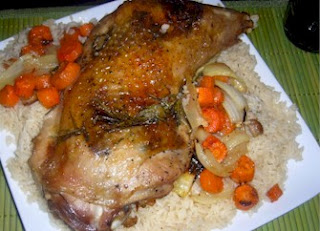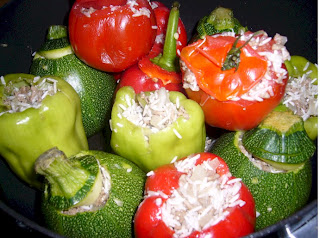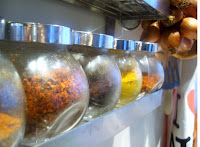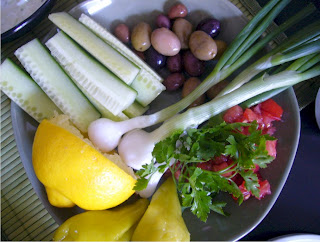Thanksgiving dinner at our house was never like the ones we saw on TV. Growing up we never had pumpkin pie, cornbread stuffing or yams. The turkey was always there but everything else on the table was pretty "un-American" and I’m pretty sure not on the pilgrim’s table.
The typical thanksgiving menu at our house had a huge, deliciously moist turkey stuffed with vegetables like potatoes, celery, and carrots, instead of stuffing we had pilaf with bits of ground beef and toasted pine nuts, and the sides were hummus, cheese bouregs, ground beef keftas, tabouleh, roasted eggplants, and plenty of pickled vegetables and olives.
After a decade and a half in the States, my mother got a little curious and more daring (or she was tired of me asking about yams and cranberries). “Sweets during the main course???” It was absolute madness for her (just like my insistence to try peanut butter and jelly sandwiches), but she gave in. "I made these especially for Seta," she announces to the confused faces around the table as she sets down a tiny bowl of cranberry sauce next to the hummus and candied yams next to the baklava.
Our dinners growing up might not have been traditional but for us they were what Thanksgiving is about – our big family getting together, squeezing around the dining table, talking over each other, overfilling our plates, and eating until we can’t move. Occasionally we attempted to go around the table and give thanks like we saw in the movies, but mostly we heard thinly veiled speeches from our uncles and aunts about marriage and children and what are we kids waiting for…they want grandkids already!! Akh….Thanksgiving.
So it’s a week after actual Thanksgiving, and my girlfriends are coming over. I can’t find whole turkeys here in
I didn’t find a recipe for Cuisse de Dinde in any of the cookbooks I had or on line so I got ideas from a few sources like from Jamie Oliver’s classic roast chicken recipe, and made up a simple way to make it happen.
Cuisse de Dinde Rôti et Parfumée / Herb-Roasted Turkey Leg
Serving 4
1kg/2 pounds
3 garlic cloves (each one cut into half)
3 tablespoons butter (room temperature)
1 tablespoon rosemary (fresh preferred)
1 tablespoon thyme (dried ok)
2 medium or 1 large onion
4 carrots
2 stalks celery
Preheat the oven to 200 C / 400 F .
Wash and pat dry a 2 pound leg. Place the turkey in a roasting pan. With a sharp knife, gash the leg in six places, particularly near the joint and in the meatiest part. Push in a half of a garlic clove in each gash.
Chop the rosemary and thyme finely. In a small bowl, mix the butter with the herbs, mashing the herbs into the butter with a fork. Lift the skin of the turkey leg creating areas of separation between the skin and the flesh of the turkey. With your fingers spread as much of the butter under the skin as you can. One way to do this is by placing a dab of the herb butter under the skin then pressing down with your palm over that area.
Tip: While you’re at it, might as well make some extra herbed butter for serving with bread. Use the same proportions of butter to herbs, depending on how much herbed butter you want. However, if you are using fresh herbs, keep in mind that it won’t last as long as if you use dried herbs. It doesn’t take long to make, so make only enough as you intend to use that day. Also, be careful not to cross-contaminate with the turkey.
Slice the carrots and celery to one inch thick pieces. Cut the onion into eight pieces (e.g., quarter the onion and then halve each quarter). Arrange the vegetables around the turkey leg. Drop the rest of the butter on top of the vegetables. Spread a tablespoon of olive oil evenly on the surface of the turkey, placing it in the pan with the skin side up. Sprinkle the turkey and vegetables with plenty of kosher salt and freshly ground pepper.
Place the pan in the oven and let brown for 10 minutes, then flip over (adding olive oil to the new side before putting it back in the oven). Let the underside of the leg roast for 10 minutes, and then flip it back to skin side up. Continue letting it roast for a total of 45 minutes per 2 lbs of meat. Check in on it time to time and baste it with some of the juices from the bottom of the pan. If the skin is getting too browned and you fear that it might burn, cover the turkey with a tent of foil.
Once done, pull out the roasting pan and let the turkey rest for at least five minutes before cutting into it. During this time you can make the pilaf.
Pilaf
2 cups long-grain rice
1 ½ cup water
1 cup chicken or vegetable broth
2 tablespoons of the turkey juices from the roasting pan
Salt
1 tablespoon butter (optional)
Bring the salted water and broth to a boil. Once boiled add the turkey juices and stir. Add the rice, bring the temperature down to low, and cover. Follow instructions for the rice you use (cooking time can vary from 10 minutes to 20). Once cooked (all the water has been absorbed), add a tablespoon of butter and stir it in, if you wish).






